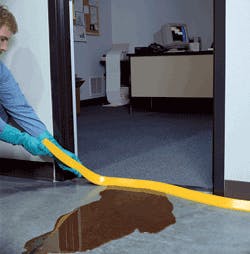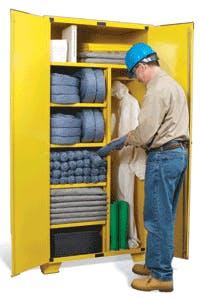Like a multi-function knife, a well-prepared spill-prevention plan is a versatile tool that can be used for many purposes.
For example, EPA's stormwater regulation and spill-prevention control and countermeasure regulation both have spill-prevention planning elements that can be served by a single well-designed spill-prevention plan.
On the safety side, managing chemicals and preventing spills can overlap with the facility's hazard communication plan. And because spills are a risk factor for slips and falls, an effective spill-prevention plan can help reduce injuries and enhance the overall safety program.
A Threat to the Environment and Workers
Spills can pollute the air, water and soil. That's the main reason that EPA requires facilities to develop plans for preventing and mitigating spills.
But spills also interrupt workflow, resulting in unplanned downtime and increasing the risk of exposure to health hazards – which is why a spill-prevention plan can serve a number of purposes.
Because every facility is unique, EPA does not mandate specific spill-prevention procedures, devices or techniques. Facilities have the liberty of choosing the methods and devices that will meet their specific needs.
Some of the common best practices for preventing spills include providing secondary containment for containers and bulk tanks, stocking spill kits in spill-prone areas and establishing good housekeeping procedures throughout the facility.
These practices often support other EHS goals, and can be incorporated into a spill-prevention plan.
Identifying Hazardous Materials
The first step in creating a spill-prevention plan is to know what hazardous materials are kept on site, and their volumes and locations. Knowing this information can help determine the scope of the plan.
Several regulations, such as OSHA's hazard-communication standard and EPA's risk-management-plan standard, require facilities to keep accurate chemical inventories. If these already have been established, there is no need to reinvent them when creating a spill-prevention plan.
Using the chemical inventory that was generated for other plans is useful when creating a spill-prevention plan, because it can serve as a checklist to ensure that all chemicals and storage areas are identified and marked on a site map.
Purchasing records also can be useful – especially as a second check for facilities that change processes or chemicals frequently.
Floor Safety
Slips and falls to the same level are the leading cause of lost-worktime injuries, according to the Bureau of Labor Statistics. More than half of all slip and fall injuries are caused by problems with the walking surface, and include leaks, drips and spills that are not cleaned up promptly.
Consequently, having a spill-prevention plan can enhance floor-safety efforts.
It's true that manufacturing processes producing constant overspray can undermine good housekeeping efforts. However, a plan that outlines proper fluid handling and good housekeeping procedures in areas where fluids are transferred can help minimize the leaks and spills that often are common in fluid-dispensing and waste-collection areas.
Fugitive Emissions
Open vats and containers allow volatile organic compounds and other vapors to escape, contributing to air pollution, jeopardizing employee health and increasing the risk of fires and explosions.
Open containers also can increase the likelihood of spills if the containers are bumped or accidentally overturned.
pill-prevention plans that include standard operating procedures for keeping containers closed when they are not in use can help prevent open containers from becoming a problem.
Establishing a routine inspection schedule for containers as well as pipelines, hoses, pumps and other fluid-transfer equipment also can help to prevent spills by identifying small problems such as minor leaks and drips so that they can be fixed before they cause a large problem.
Spill-Response Procedures
Spill-prevention plans focus on the proactive steps that a facility will take on a routine basis to prevent spills from occurring. In the event that these best practices fail, response plans contain written procedures that instruct responders on the proper way to handle spills safely, quickly and effectively.
These response plans should be communicated to all employees, and drilled regularly to ensure that everyone knows what they are expected to do when a spill happens – even if their only action is to evacuate the area.
Plans also should list emergency contacts and the spill-response equipment that is available to responders.
Waste and Disposal
Sometimes, spilled liquids can be recovered for reuse within a process. But in the case of specialty lubricating fluids and feedstocks or chemicals that need to remain in a pure state, spills often create a large amount of waste that needs to be sent for recycling or disposal.
An effective spill-prevention plan will minimize the potential for spills and help eliminate large volumes of spill-related waste.
For facilities subject to Resource Conservation Recovery Act generator standards, minimizing spills and related wastes can help prevent the facility from being bumped into a higher generator status.
HAZWOPER
Workers who will respond to emergency spills must be appropriately trained in accordance with OSHA's Hazardous Waste Operations and Emergency Response (HAZWOPER) regulation. As part of this regulation, facilities must have a spill-response plan.
Many of the storage and handling procedures, as well as containment products and spill-response tools that are outlined in a spill-prevention plan, are useful to the responders who are called upon to mitigate a spill emergency.
A Versatile Tool
The goal of a spill-prevention plan is to help avoid spills by documenting the guidelines, procedures and devices that a facility will use to keep hazardous materials out of the environment. However, as we've seen, many of the same planning elements support other EHS efforts.
Also, coordinating planning efforts and using one plan to satisfy multiple needs help facilitate training and enhance understanding of how different EHS plans work together to protect both employee and environmental health.
Karen Hamel is a technical specialist for New Pig Corp. A graduate of the University of Pittsburgh, she has more than 19 years of experience helping environmental, health and safety professionals find solutions to meet EPA, OSHA and DOT regulations. Contact her at [email protected].


